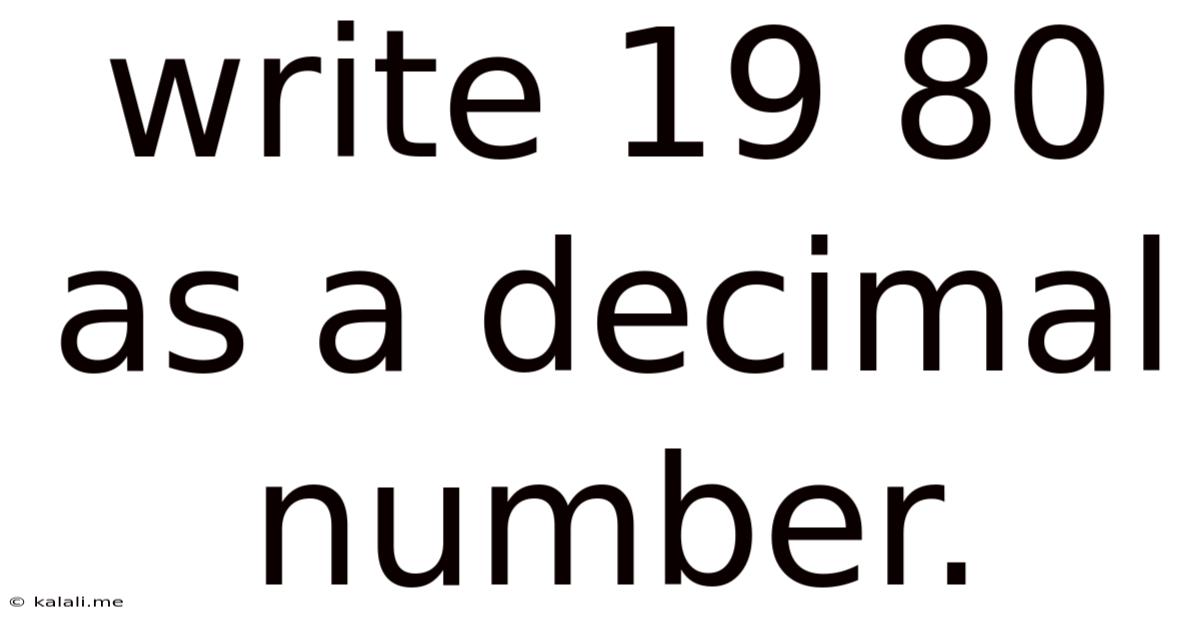Write 19 80 As A Decimal Number.
Kalali
Jul 23, 2025 · 4 min read

Table of Contents
Writing 19/80 as a Decimal Number: A Comprehensive Guide
This article delves deep into the process of converting the fraction 19/80 into its decimal equivalent. While seemingly simple, this conversion offers an excellent opportunity to explore fundamental concepts in mathematics, highlighting different methods and reinforcing understanding of fractions, decimals, and their interrelationships. We'll cover various approaches, from manual long division to utilizing calculators and exploring the underlying mathematical principles. This guide aims to be comprehensive, beneficial for students learning about fractions and decimals, and a useful resource for anyone needing a refresher on these core mathematical concepts.
Understanding Fractions and Decimals
Before diving into the conversion, let's establish a clear understanding of fractions and decimals. A fraction represents a part of a whole, expressed as a ratio of two numbers – the numerator (top number) and the denominator (bottom number). The denominator indicates the number of equal parts the whole is divided into, while the numerator shows how many of those parts are being considered.
A decimal is another way of representing a part of a whole. It uses a base-ten system, with digits to the right of the decimal point representing tenths, hundredths, thousandths, and so on. Decimals are particularly useful for representing parts of a whole in a way that's easily comparable and manipulated in calculations.
Method 1: Long Division
The most fundamental method for converting a fraction to a decimal is through long division. We divide the numerator (19) by the denominator (80):
0.2375
80 | 19.0000
-160
300
-240
600
-560
400
-400
0
Therefore, 19/80 expressed as a decimal is 0.2375. This method demonstrates the process explicitly, reinforcing the relationship between fractions and decimals. It’s a valuable skill to master, even in the age of readily available calculators.
Method 2: Finding Equivalent Fractions
Another approach involves finding an equivalent fraction with a denominator that's a power of 10 (10, 100, 1000, etc.). This allows for a direct conversion to a decimal. However, in this specific case (19/80), finding a simple equivalent fraction with a power of 10 denominator is not straightforward. While we could multiply both the numerator and denominator by various numbers, it wouldn't yield a denominator that's a clean power of 10. This highlights that long division is often the more practical approach for fractions like 19/80.
Method 3: Using a Calculator
Modern calculators simplify the process significantly. Simply input 19 ÷ 80, and the calculator will directly provide the decimal equivalent: 0.2375. While convenient, understanding the underlying long division process remains crucial for developing a solid mathematical foundation. Calculators are tools that enhance efficiency, but the conceptual understanding shouldn't be sacrificed for convenience.
Understanding the Decimal Result: Significance of Place Value
The decimal 0.2375 is composed of:
- 0: The whole number part (there are no whole units).
- 2: Represents two-tenths (2/10).
- 3: Represents three-hundredths (3/100).
- 7: Represents seven-thousandths (7/1000).
- 5: Represents five ten-thousandths (5/10000).
Understanding place value is crucial in interpreting decimals correctly. Each digit's position relative to the decimal point determines its value.
Applications and Real-World Examples
The conversion of 19/80 to 0.2375 has practical applications across various fields:
-
Percentage Calculations: To express 19/80 as a percentage, multiply the decimal by 100: 0.2375 * 100 = 23.75%. This could represent a discount, a grade on an exam, or many other scenarios.
-
Measurement and Engineering: In engineering and scientific applications, precise measurements are often expressed as decimals. Converting fractions to decimals ensures compatibility and ease of calculation.
-
Financial Calculations: In finance, interest rates, returns on investment, and other calculations frequently involve decimals.
-
Data Analysis: When working with data, converting fractions to decimals often simplifies analysis and comparisons.
Further Exploration: Recurring Decimals
Not all fractions convert to terminating decimals like 19/80. Some fractions result in recurring decimals – decimals with a repeating sequence of digits. For example, 1/3 converts to 0.3333... (the 3 repeats infinitely). Understanding the difference between terminating and recurring decimals is an important aspect of number systems.
Conclusion: Mastering Fraction-to-Decimal Conversions
Converting fractions to decimals is a fundamental skill in mathematics with broad applications. While calculators offer a quick solution, understanding the underlying methods, particularly long division, is essential for a deep understanding of mathematical concepts. This article has explored various approaches, highlighting the significance of place value and providing real-world examples to showcase the practical utility of fraction-to-decimal conversions. By mastering this skill, individuals can confidently tackle more complex mathematical problems and effectively apply these concepts in various fields. The conversion of 19/80 to 0.2375 serves as a clear and practical example to reinforce these fundamental concepts. Remember, the key is not just knowing the answer but also understanding the why behind the process.
Latest Posts
Latest Posts
-
How Many Ounces Are In A Pound Of Meat
Jul 24, 2025
-
Do You Know How To In Spanish
Jul 24, 2025
-
How Long Would It Take To Drive 90 Miles
Jul 24, 2025
-
How Many Feet In A Yard Stick
Jul 24, 2025
-
How Many Feet Are In 8 Miles
Jul 24, 2025
Related Post
Thank you for visiting our website which covers about Write 19 80 As A Decimal Number. . We hope the information provided has been useful to you. Feel free to contact us if you have any questions or need further assistance. See you next time and don't miss to bookmark.